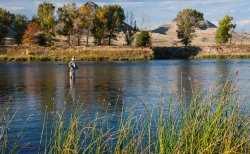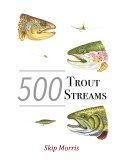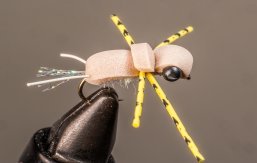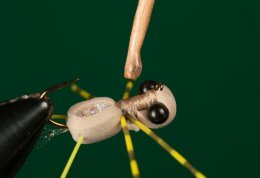Ten Ways to Improve Your Nymph Fishing
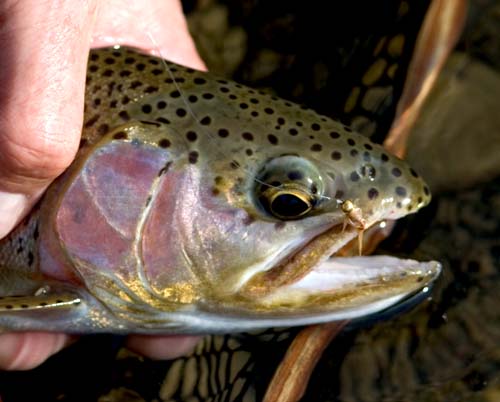 Use Skip's ten ways to improve your nymph
Use Skip's ten ways to improve your nymph
fishing to help you land more trout
I often fish with newbies—friends and relatives who range from only lightly experienced fly fishers to the completely uninitiated.
So, I frequently wind up as an instructor.
It's a natural role for a writer of fly-fishing and fly-tying how-to books and I enjoy it.
The Tips and Tricks of Successful Nymph Fishing
Over the years I've noticed that high on the list of areas where rising fly fishers have trouble is the whole business of fishing nymphs in rivers.
With nymphing, if you miss a few key points, you're practically out of the game.
But my approach to teaching someone how to fish a nymph has evolved to where now, in fairly short order, I can sometimes take a failing beginner to steadily catching trout with these ten ways to improve your nymph fishing.
Here are my top ten ways to improve your nymph fishing:
- Never Take Your Eyes Off the Indicator.
- Strike Immediately.
- Strike Lightly.
- if you miss the fish, you'll yank the nymph out of the drift, when after a gentle tug it could drop back down and move another trout;
- you're liable to snap your tippet and loose both fish and fly; and
- your tense body will react slowly, which will drag down your reaction time.
- Get the Fly Down to the Trout.
- Never Rush Your Cast.
- Minimize Slack Line.
- Strike at Every Sign.
- Experiment with Fly Patterns.
- Try All Water With Any Promise.
- Do it All.
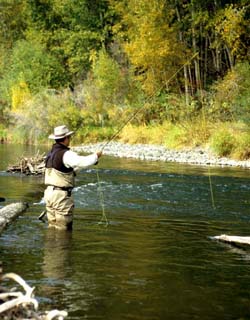
They can't—that's the rational answer. But, somehow, they do—and when the angler's eyes roam is precisely when they take a nymph.
I've watched a new fly fisher miss strike after strike, distracted by a bird or passing car or even the casting of another angler.
If you want to succeed at nymph fishing, you have to
watch your strike indicator constantly,
from the time it
touches the water right up until you pick it up.
Assume that a trout will take your nymph at any time during the fly's drift;
in fact a trout may.
And that brings us to the second point in Ten Ways to Improve Your Nymph Fishing...
The standard line goes something like this:
By the time you see the indicator dip or stall,
the trout is already spitting out the nymph.
The standard line is correct. Therefore, the strike has to come as soon as possible after the indicator tells—nearly immediately. This takes a little doing.
When I first tie on a nymph after winter calms down, I usually miss the first few fish as I clear the cobwebs out of my reaction time. After that, I'm in good shape for the rest of the season.
You can imagine how tricky this can be for the beginner.
Listen, it doesn't take superhuman speed to hook a trout on a nymph. Move slowly and you'll still catch some fish. A few will hook themselves solidly on their own. So don't get spooked away from nymph fishing because you fear your reflexes aren't up to the job.
But remember that a swift strike to a twitching or diving indicator will kick the action way up.
Now the third point in Ten Ways to Improve Your Nymph Fishing...
When you strike immediately, do so lightly.
Tightening your biceps and leaning back hard on the rod causes three problems:
The hard strike is all disadvantage. The light (quick) strike is all advantage.
Which brings us to the fourth point in Ten Ways to Improve Your Nymph Fishing...
If your fly isn't bumping the riverbed now and then, and especially if you're not losing an occasional nymph to a rock, then you're not doing it right.
Of course, this rule doesn't apply to methods that hold the nymph up away from the bottom of the river, such as the lightweight shallow nymph suspended from a dry fly during a hatch, and the hopper-dropper approach.
But for standard indicator nymph fishing,
the nymph-on-the-bottom rule, well...rules.
There are lots of things you can do to help a nymph sink deep. The main thing is to set the strike indicator up high enough on the leader (about twice the depth, except in the slow currents).
But a heavily weighted fly helps, and in really fast or deep water some weight up the leader—lead or lead-substitute split shot, putty, twist-ons...—can turn slow fishing suddenly to fast fishing.
Starting to make sense? The fifth point in Ten Ways to Improve Your Nymph Fishing is...
Those narrow line loops that snap the water from a dry fly and push it way out there when a long cast is required are normally murder in nymph fishing.
With a strike indicator, perhaps added weight on the leader, and a weighted fly (sometimes two or even three weighted flies), the narrow loop invites tangles.
Much better to cast lazily, smoothly, with a wide loop to keep the bouncing rig away from the line.
Learn to make a wide loop and long, smooth stroke
for casting nymphs.
Of course if you're fishing the nymph close, avoid all this by just swinging the rig out there rather than really casting at all.
You can't get into much trouble if the line and leader loop unhurriedly around behind you and then back out onto the water the same way.
Or if you just let the line straighten downstream and then chuck it back up and out in a single stroke.
Now you're getting it...so, the sixth point in Ten Ways to Improve Your Nymph Fishing is...
You'll spend your strike time picking up line—and not setting the hook until it's too late—if your line lies in too many waves and coils.
Some slack is good; it helps keep the indicator drifting freely. So expect and throw slack-creating casts, like the lazy-S cast, and to mend line.
But a little slack in your fly line is plenty. If you can pull all the slack out in a modest raise of the rod-tip, you've got all the slack you want.
What's next? The seventh point in Ten Ways to Improve Your Nymph Fishing is...
No one can really tell the tick of a stone from the light take of a trout. If you strike and nothing's there, no problem; just let the fly continue its drift.
But if you try to guess when the indicator is telling of a rock or current surge from a trout,
you'll simply
miss setting the hook on a lot of trout.
And everything the indicator does other than drift calmly is a reason to strike.
Strike indicators do go down suddenly and hard—happens all the time. But often the take of a trout is subtle, the indicator giving only a little pause or twitch.
Doesn't matter, violent or subtle—set the hook.
And now, point eight of Ten Ways to Improve Your Nymph Fishing...
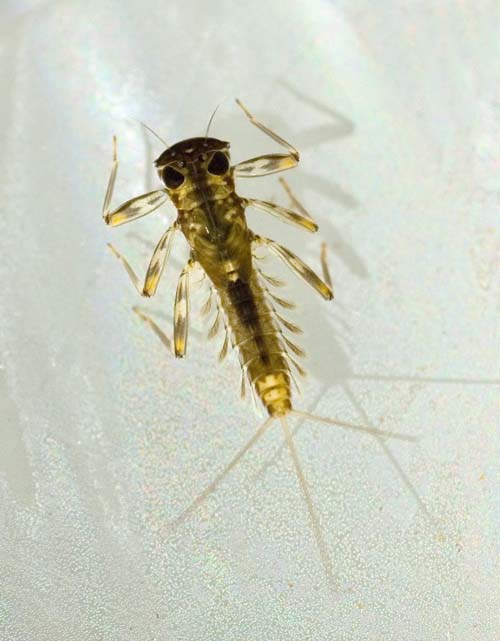 A mayfly nymph commonly found in rivers
A mayfly nymph commonly found in rivers
That Prince Nymph that killed yesterday may be useless today, because it's just an hour before the BWO mayfly hatch and the trout are busy down there scarfing up little dark nymphs; today, you'll probably do much better with a Troth Pheasant Tail or Anatomical Baetis/PMD.
Everyone expects to change dry-fly patterns, but not so many seem to understand that trout can be just as picky about nymphs.
It's difficult to tell what's going on down there.
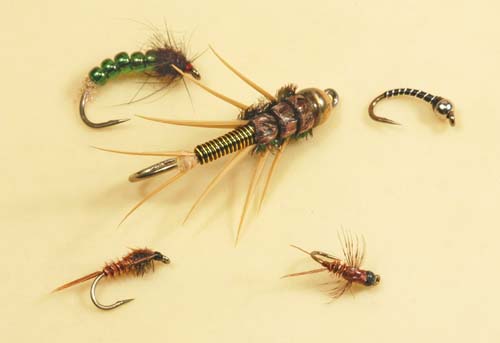 Imitative nymphs, top left to right, clockwise:
Imitative nymphs, top left to right, clockwise:
Killer Caddis, Wired Stone, Zebra Midge,
Anatomical Baetis/PMD, Troth Pheasant Tail
Are golden stonefly nymphs creeping to shore and getting swept to the trout by rogue currents?
You probably won't know until you've failed with a variety of caddis-larva and midge and mayfly imitations and have got around to that big gold-and-brown pattern. (Of course, if you know your hatches well, you would have known that it was a good time to expect the golden stone and might have got to the right fly in short order...)
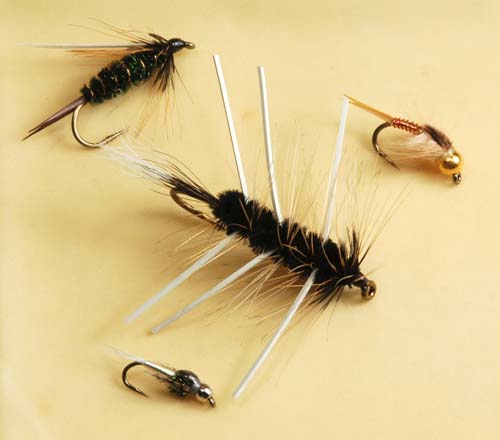 Attractor nymphs, top left to right, clockwise:
Attractor nymphs, top left to right, clockwise:
Prince Nymph; Gabriel's Trumpet, Gold;
Yuk Bug; Copper John, Silver
But it's not always about imitation. If an attractor nymph seems appropriate—as when there's no evidence of a hatch and imitative nymphs are doing little—try a Copper John, Silver; then a Gabriel's Trumpet, Gold; then a Yuk Bug and you'll probably find that one will out produce the others, perhaps by a landslide.
Though none of these flies really imitates anything, the trout will typically prefer one or the other, and their preference will likely change from season to season, day to day, even hour to hour.
It's just a fact. If you figure out why, please tell the rest of us.
On to point nine of Ten Ways to Improve Your Nymph Fishing...
Run your nymph through every riffle or run or pocket that seems even slightly plausible, at least until you figure out where the trout seem to be holding right now. If you do stick to only the most promising spots, you may find that the trout didn't.
Case in point: I was fishing a Colorado creek last month and none of us found a thing in the long, deep near-perfect runs. But I hooked half a dozen browns in fairly short order by passing my nymph through quick little current lines between even quicker ones in the rapids.
Such events are common. Here again, tell us when you figure out the reason.
And don't overlook shallow water, the water beginners often tromp right into before they start fishing, because it can also offer promise—trout, including some big ones, really will hold in a foot of streamy current.
So run a nymph through plausible shallow water a few times before you consider stepping into it.
And the last point in Ten Ways to Improve Your Nymph Fishing...
Czech nymphing, with the downstream draw of the rod, close in, and a heavy nymph holding down another lighter nymph or two, is all the rage. And it may be just the thing for those side channels off a big river or the riffles of your favorite creek.
But if you need to punch a nymph out fifty feet, Czech nymphing is useless, and long-range nymphing is just right. So be prepared to apply either technique, or both, in a day's nymph fishing.
Same goes for the hopper-dropper and the swimming nymph on a sinking line and the rest—be open to changing techniques and know how to make each of them work.
All nymph-fishing techniques have their appropriate times and places.
Although it's common to find that two or even three techniques may work equally well in a given situation. As when my friend Doug fished in standard indicator style while I fished the Czech nymph technique on a small local river last summer and had about equal, and very good, action.
Techniques for nymphs learned from experience...
These are the principles I teach to nymph-fishing newcomers, and they are principles I came to the hard way—by catching, and failing to catch, a lot of trout over hundreds of fishing days.
Follow all ten ways to improve your nymph fishing and you'll almost
certainly find your fishing mostly good to occasionally red hot.
Click here to hear Skip's interviews on popular podcasts...
*Announcements*
Skip has an essay in Big Sky Journal's annual Fly Fishing issue, called "Montana Hoppers: the Princess and the Brute" released February 1, 2023. Skip rewrote it a bit; I painted and illustrated it here, on our website. Here's the link on our web page to check it out:
Click here to read Skip's essay Montana Hoppers: The Princess and the Brute...
Skip's latest books:
Top 12 Dry Flies for Trout Streams: How, When, and Where to Fish Them, is now available on Amazon as an ebook...check it out! Click on the links below to go to the information page on Top 12 Dry Flies (the link to Amazon is at the bottom of the page...)
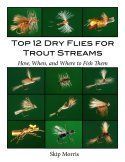 Top 12 Dry Flies for Trout Streams: How, When, and Where to Fish Them
Top 12 Dry Flies for Trout Streams: How, When, and Where to Fish Them
Click here to get more information about
Top 12 Dry Flies for Trout Streams: How, When, and Where to Fish Them (the link to Amazon is at the bottom of the page)...
Top 12 Dry Flies for Trout Streams: How, When, and Where to Fish Them (the link to Amazon is at the bottom of the page)...
Top 12 Nymphs for Trout Streams: How, When, and Where to Fish Them, 2nd Edition, originally published as an e-book only, is now available on Amazon as a paperback...check it out! Click on the links below to go to the information page on Top 12 Nymphs (the link to Amazon is at the bottom of the page...)
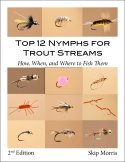 Top 12 Nymphs for Trout Streams: How, When, and Where to Fish Them (2nd Edition)
Top 12 Nymphs for Trout Streams: How, When, and Where to Fish Them (2nd Edition)
Click here to get more information about
Top 12 Nymphs for Trout Streams: How, When, and Where to Fish Them (2nd Edition). . .
Top 12 Nymphs for Trout Streams: How, When, and Where to Fish Them (2nd Edition). . .
Click here to get more information about Skip's e-book,
500 Trout Streams...
500 Trout Streams...
Skip's latest paperback book:
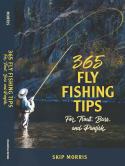 365 Fly Fishing Tips for Trout, Bass, and Panfish
365 Fly Fishing Tips for Trout, Bass, and Panfish
Click here to get more information about Skip's latest book,
365 Tips for Trout, Bass, and Panfish...
365 Tips for Trout, Bass, and Panfish...
Print Skip's chart for FREE:
Skip Morris's Trout-Fly Proportion Chart
Go to Skip Morris's Trout Fly Proportion Chart
Skip's Predator is available to buy...
Skip's ultra-popular Predator—a hit fly for bluegills and other panfishes and largemouth bass (also catches smallmouth bass and trout)—is being tied commercially by the Solitude Fly Company.
The Predator
CLICK HERE to learn more about or to purchase the Predator...
Learn to Tie Skip's Predator
Do you want to tie the Predator?
Tying the Predator
Skip shows you how to tie it on his YouTube Channel link, listed below:
CLICK HERE to see Skip's detailed video on how to tie the Predator...





